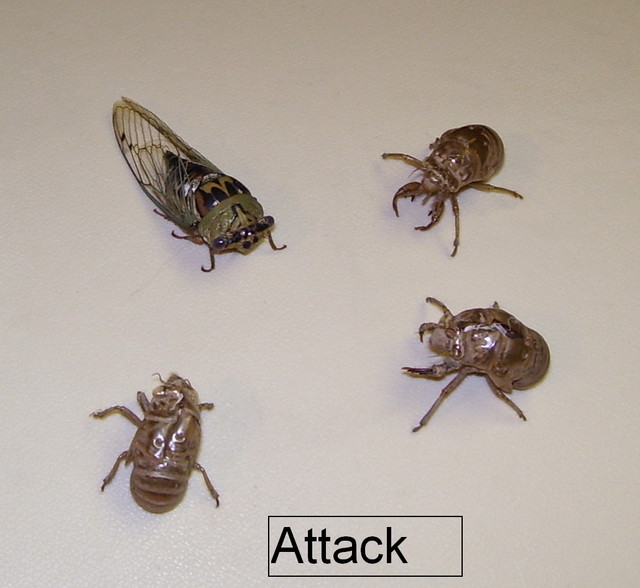
What is it?
Moderators: TomM, Moderator, wesk
- Cacti_Ken
- Member
- Posts: 1021
- Joined: Tue Apr 19, 2005 6:00 pm
- Location: Silsbee, Texas
What is it?
Who would know the correct name for this Bug? Around here we call them Locust.


Tropical Veteran
35th Inf. Reg. "CACTI" 4th I.D. VN
Amateur Radio K5XOM
35th Inf. Reg. "CACTI" 4th I.D. VN
Amateur Radio K5XOM
- BEAR
- Member
- Posts: 19
- Joined: Fri Jul 06, 2007 6:00 pm
- Location: "SUNNY" WESTERN AUSTRALIA
G'day Ken, I dont know, but the one on the top right looks like some sort of what we here in west aus call a cicada or a cricket, (a bit different spieces than we get here though)  The one on the top right looks like an ant lion. I'm probably completly wrong but thats what they look like to me.
The one on the top right looks like an ant lion. I'm probably completly wrong but thats what they look like to me. 
Cheers Ray (BEAR)
Cheers Ray (BEAR)
- Ryan_Miller
- Site Administrator

- Posts: 1671
- Joined: Sat Apr 02, 2005 6:00 pm
- Location: Kansas
Ken,
Here is a little info I dug up for you.
Entymology has always been an interest of mine.
Kingdom: Animalia
Phylum: Arthropoda
Class: Insecta
Order: Hemiptera
Suborder: Auchenorrhyncha
Infraorder: Cicadomorpha
Superfamily: Cicadoidea
Family: Cicadidae
A cicada is an insect of the order Hemiptera, suborder Auchenorrhyncha, in the superfamily Cicadoidea, with large eyes wide apart on the head and usually transparent, well-veined wings. There are approximately 2,500 species of cicada around the globe, and many remain unclassified. Cicadas live in temperate to tropical climates where they are one of the most widely recognized of all insects, mainly due to their large size and remarkable (and often inescapable) acoustic talents. Cicadas are sometimes incorrectly called "locusts"[1], although they are unrelated to true locusts, which are a kind of grasshopper. Cicadas are related to leafhoppers and spittlebugs. In parts of the southern Appalachian Mountains in the United States they are known as "dry flies" because of the dry shell they leave behind.
Cicadas do not bite or sting, are benign to humans, and are not considered a pest. Many people around the world regularly complement their standard diet with cicadas: the female is prized for eating as it is meatier. Cicadas have been eaten (or are still eaten) in Ancient Greece, China, Malaysia, Burma, Australia, Latin America and the Congo. Cicadas are employed in the traditional medicines of China and Japan for hearing-related matters.[citation needed]
The word cicada is a direct derivation of the Latin cicada, meaning "tree cricket"; in Greek they are referred to as tzitzikia or tettix.

Here is a little info I dug up for you.
Entymology has always been an interest of mine.
Kingdom: Animalia
Phylum: Arthropoda
Class: Insecta
Order: Hemiptera
Suborder: Auchenorrhyncha
Infraorder: Cicadomorpha
Superfamily: Cicadoidea
Family: Cicadidae
A cicada is an insect of the order Hemiptera, suborder Auchenorrhyncha, in the superfamily Cicadoidea, with large eyes wide apart on the head and usually transparent, well-veined wings. There are approximately 2,500 species of cicada around the globe, and many remain unclassified. Cicadas live in temperate to tropical climates where they are one of the most widely recognized of all insects, mainly due to their large size and remarkable (and often inescapable) acoustic talents. Cicadas are sometimes incorrectly called "locusts"[1], although they are unrelated to true locusts, which are a kind of grasshopper. Cicadas are related to leafhoppers and spittlebugs. In parts of the southern Appalachian Mountains in the United States they are known as "dry flies" because of the dry shell they leave behind.
Cicadas do not bite or sting, are benign to humans, and are not considered a pest. Many people around the world regularly complement their standard diet with cicadas: the female is prized for eating as it is meatier. Cicadas have been eaten (or are still eaten) in Ancient Greece, China, Malaysia, Burma, Australia, Latin America and the Congo. Cicadas are employed in the traditional medicines of China and Japan for hearing-related matters.[citation needed]
The word cicada is a direct derivation of the Latin cicada, meaning "tree cricket"; in Greek they are referred to as tzitzikia or tettix.

Ryan Miller
MVPA # 22010
MVPA # 22010
- Cacti_Ken
- Member
- Posts: 1021
- Joined: Tue Apr 19, 2005 6:00 pm
- Location: Silsbee, Texas

